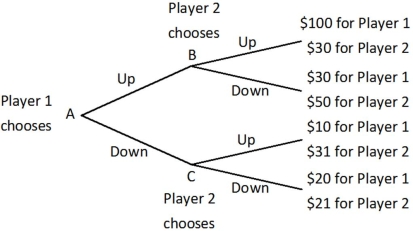Player 1 and Player 2 are playing a game in which Player 1 has the first move at A in the decision tree shown below. Once Player 1 has chosen either Up or Down, Player 2, who can see what Player 1 has chosen, must choose Up or Down at B or C. Both players know the payoffs at the end of each branch.  Suppose Player 1 and Player 2 enter into a binding agreement in which Player 1 agrees to pay Player 2 a fixed amount of money to get Player 2 to play Up when it is Player 2's turn. How much will Player 1 have to pay Player 2 to get Player 2 to play Up?
Suppose Player 1 and Player 2 enter into a binding agreement in which Player 1 agrees to pay Player 2 a fixed amount of money to get Player 2 to play Up when it is Player 2's turn. How much will Player 1 have to pay Player 2 to get Player 2 to play Up?
Definitions:
Looking Glass Self
A concept in social psychology suggesting that an individual's self-concept is influenced by how they believe others perceive them.
Generalized Other
A conception of the attitudes and expectations held in common by the members of the organized groups with whom one interacts.
Acting Reflexively
Responding or reacting automatically to stimuli without conscious thought.
Peripheral Membership
A form of association where individuals are marginally involved or partially included in a group or organization.
Q12: Hiding a text file in a jpg
Q16: _ is a form of cryptography technology
Q21: Refer to the figure below. <img src="https://d2lvgg3v3hfg70.cloudfront.net/TB3719/.jpg"
Q21: A registration authority is the PKI component
Q27: Nonrepudiation means that the person who sends
Q28: If an individual producer is willing to
Q32: The term which refers to the attempt
Q36: The X.509 standard outlines the necessary fields
Q48: One difference between the long run and
Q114: Once a firm has determined the quantity